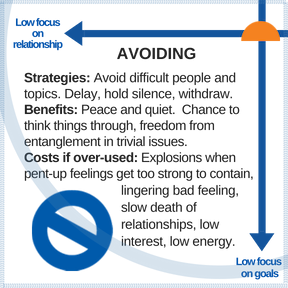![]() You Scored High in Avoiding in Storm
You Scored High in Avoiding in Storm ![]()
This suggests that, when stress and tension are high, you step back or withdraw in order to keep things calm. Avoiding has unique strengths and weaknesses that you should be aware of.

Avoiding has Important Uses. Strengths associated with wise use of this style include:
- Ability to stay out of needless battles over trivial issues not worth the time and energy consumed by confrontation.
- Calmness and stability.
- Conservation of time and energy.
- Caution in the face of risk. Avoiding allows for caution and planning. It gives space to think things through, pay attention to details, and count the cost. Avoiders are not quick to jump into something new or risky, and if their needs for forethought and careful procedure are addressed, they may bring unusual reliability to implementing agreements that result.
But Don't Over-Use It. Each style has costs that come with over-reliance on that style. With Avoiding, these are not immediately obvious - things may stay quiet for a while! But over-use of Avoiding has high long-term costs. These include:
- Paralysis or lack of resolution of important issues.
- Periodic explosions of pent-up anger. Avoiding does not resolve conflict; it only prevents confrontation. At a certain point, your anger may reach a level where you are no longer able to be silent and contain it. This can create "long stretches of cottony silence interrupted by periodic explosions", as one person described patterns in a conflict avoidant group.
- A residue of bad feelings that can poison the whole relationship, leading to...
- Slow death of relationships.
- Stagnation, dullness, declining interest and energy.
- Loss of engagement, trust, and accountability with others.
How to Maintain Balance with Avoiding. You can take steps to experience more benefits of wise use of Avoiding and fewer costs of overuse:
- Recognize conflict as an inevitable part of life that can in fact bring valuable results. There are many websites and books on skills for conflict resolution. See the section on Avoiding in the Free Web Resources page on our site for ideas. Studying these may increase your confidence that you can indeed talk about and resolve differences.
- Expand use of other styles so you are less likely to over-use Avoiding. Try Compromising - it shares a concern held by Avoiding not to prolong discussion over differences. Yet Compromising invests at least some effort in discussion and actively seeks a reasonable compromise.
- Approach important conversations and decisions in phases. Some Avoiders have a strong orientation towards examining details and understanding implications before committing to things. They are likely to say NO to anything requiring an immediate answer. If you recognize this in yourself, approach discussion in ways that turn this pattern into a strength. Request a several step approach to discussion:
First step, a discussion to identify the issues or problems.
Second step, study or think about the issue on your own.
Third step, return for a discussion with others. Know that other styles, particularly Directing, prefer immediate discussion and resolution, but will usually accept a phased approach if spelled out specifically - when, where, how long, etc. - Give yourself space to examine facts, details, precedents, etc., as part of a negotiation process.
- Read or take a course in assertiveness skills.
- Maintain personal disciplines of rest, reflection, quietness, journaling, etc. This helps all styles, and none more so than Avoiders.

- Stay low-key. When others are intense or demanding, an Avoider may avoid even more. Try to create safe space, rather than goading an Avoider to engage.
- Give space and time to withdraw and think things through. More than other styles Avoiders need this.
- Move slowly, one step at a time. Haste in decision making can push Avoiders into withdrawal or analysis paralysis.
- Provide information with time to review it. Some Avoiders are task focused in a particular way: They bring caution and attention to detail to everything they do. They take care not to put important things at risk. They want to be reliable and consistent. These Avoiders need data and information, presented in a calm and methodical way, in order to comfortably enter negotiations. Others should make special efforts to provide them with relevant details, about plans, options, costs, rules, precedents from elsewhere, expected results, how surprises will be dealt with, etc. If possible, give an Avoider time to absorb this information before expecting to negotiate.
- Use a three-step approach. Others are more likely to get a "yes" answer from an Avoider with a "three-step" approach. First: Let an Avoider know - in a relaxed way - that a discussion is needed and request a time to have this. Second: Give time for the Avoider to think things through - an hour, a day, or a week. Third: Have the discussion.



 Need assistance? Email center@riverhouseepress.com with a copy of the login instructions you received and a brief description of what is happening. We'll reply in one business day-usually less.
Need assistance? Email center@riverhouseepress.com with a copy of the login instructions you received and a brief description of what is happening. We'll reply in one business day-usually less. 